
I was struck by Sunil’s post about his alteration/destruction of work into which he had put so much effort. In fact, I liked his revised “Palimpsest” very much, although I can see that it doesn’t resemble much of what he has shown us before this.
Because I have so many failed, partly completed, destroyed, altered, and despised pieces sitting around in boxes, baskets, photos and my memory, I thought I’d run through a taxonomy of my bad work and its place in my art-making universe. Ultimately my question is whether I’ve made adequate categories of “failure” or if there are others that could be added; in addition, I wonder if you can suss out what “runs” your failures — what, particularly if it’s not just a problem of quality, causes you to throw up your hands and ditch work.
So here are my categories. There’s work that simply fails — period, full stop. There’s work that gets altered, thus morphing into something else. There are series that come to an abrupt halt. And finally there’s work that’s put on hold.
Failed work has its own subcategories, of course, including failures to work the materials, failures of skill, failures of insight, and failures of resonances within one’s conceptual worlds.

Big Hair failed on many accounts and has finally been recycled. I may have started to quilt it to add texture, but whatever I did, didn’t save it. I think my abilities outran my concept and then my concept became boring. And ultimately there may have been a failure to work the materials adequately, although that’s more easily remedied.

Blanche’s Eyes, while not meant to refer to Muslim women, did, and thus my intent was radically changed. It was a failure of insight. I never got far enough into it to decide if it could have been saved if the contextual references weren’t so strong. (Blanche was my Anglo protestant grandmother whom I never knew except through a few sentences of my mother’s and an elegant photo that I painted many times).
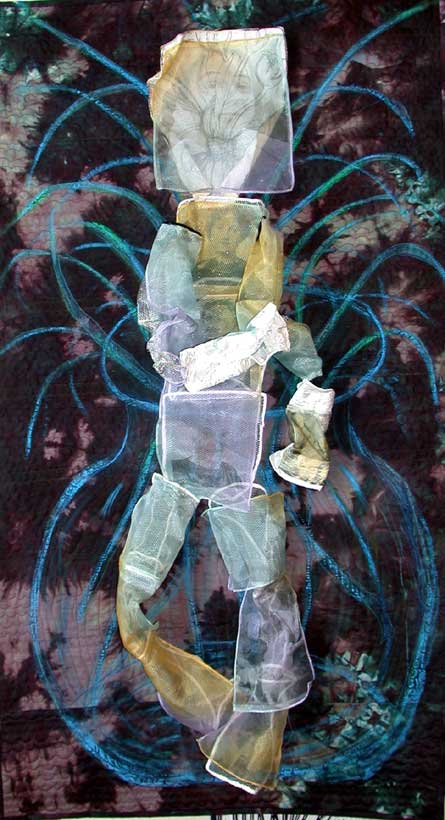
Kid with Vase was one of many pieces I produced while playing around with wire and textiles. I ultimately produced and exhibited some of these wire pieces, but this one never jelled for me. I think it was too cute and therefore offended my sensibilities — a failure of “resonance.” It was also difficult to make the materials secure enough to think about exhibiting. The quilted under-piece was set aside and then exhibited and finally sold. The Kid is still hanging in the basement, altered with some soaring wings. Still too cute.
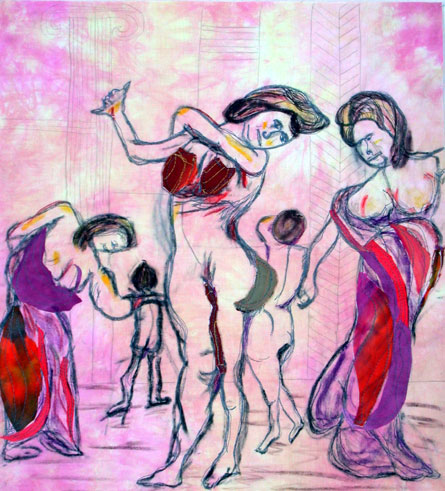
I did a whole series of these dancing or moving female figures, in various modes:
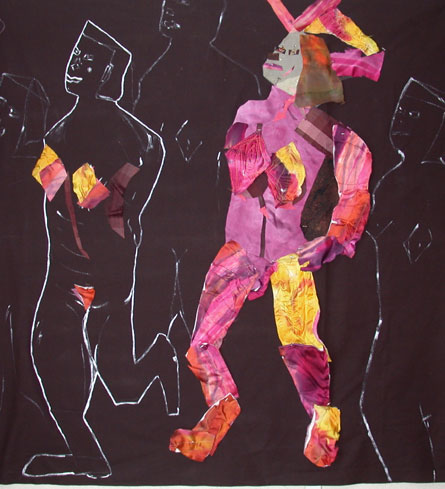
With the female figures, I think there was a failure of ability and resonance. In the end, I wasn’t sure what I wanted them to present, what it was I was trying to express. But I did figure out a more meaningful (to me) direction for playing with the human figure — more about that at the end of the post.
Then there are the pieces that get modified until they are more or less acceptable:
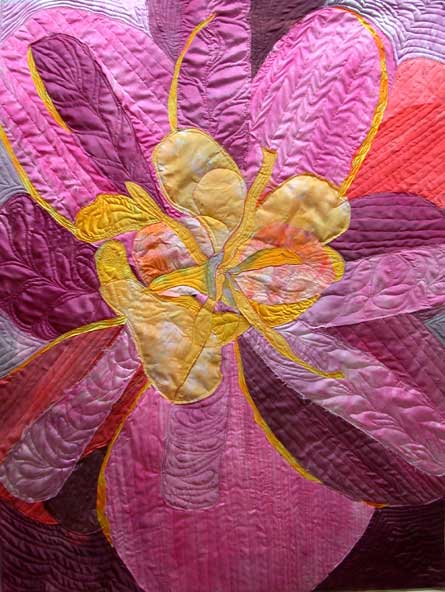
The version above was somewhat evocative, but much too pink. I was working on a series that I called “Interiors” (referring to human psyches) and needed to internalize the image somewhat more, which I did, as seen below. (The triangles unbutton, like a coat.)
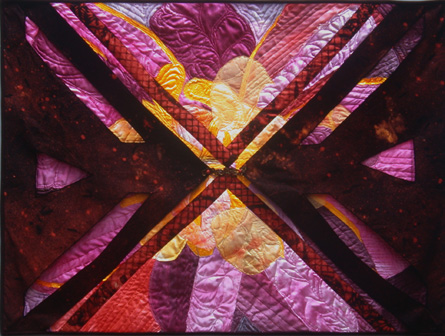
I also have series that just get halted, where I failed in both imagination and concept.
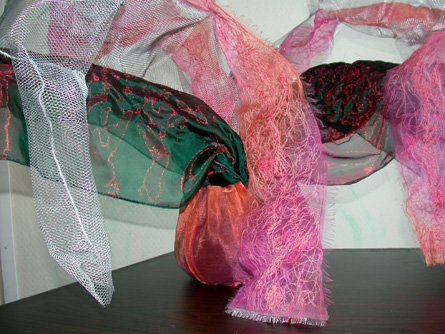
Audrey (referencing the Little House of Horrors) was the final of four of these winged creatures, devised of chicken wire, silk, and other unlike elements. I liked all four of them (and am particularly fond of Audrey) but they are more whimsy than anything else. And my store of whimsy got quickly exhausted. Curators in the textile fields like these very much, probably because they were pedestal pieces instead of wall hangings, but they are difficult to ship and are now sitting around the house, waving at me as I go by.
Finally, while a whole batch of female figures are stuffed into baskets in various stages of incomplete failed-ness, they did lead to this (and a couple other) completed figures:

Mrs. Willard Waltzes with the Petunias is whimsical, but fits into my exploration of the interiors of ordinary humans as well as the richness of inner lives. And Mrs. Willard is an on-going character in one of my series that’s on hold. The image at the head of this post is of this same series — “Mrs. W. dices with the devil” is worth pursuing regardless of its particular artistic flaws. It’s part of a series that I can see extending as far as my skill and energy can carry it because it still resonates with me.
I suspect that what I call “resonance” is what Sunil would call “meaning.” Without the resonance within, I get bored or careless with my work. I can often work around failure resulting from formal art problems, but I must have the resonance to continue.
So are these categories adequate for failed work? And what are the reasons that you stop working on a piece or a series — a failure of skill? of imagination? of conceptual adequacy? Are there particular kinds of “failure” that are worth continuing to circle?

My friend Arthur likes to tell people what I once said to a counselor at an employment agency. She asked what kind of job I was looking for, and I told her I wanted a job that wouldn’t interfere w/ my career.
While there are occasionally works that I decide not to finish or directions that I abandon, I never look at those as failures. I see them as research and development. The real failures, for me, are when I get myself into a situation where my day job is interfering w/ my art.
As far as the works you’ve put up as examples of your failures, June, I think the best thing you could do with them is sell them. You may be surprised how much other people like them, and once you’ve sold them you might like them better too :)
I particularly admire two of your “failures”.
David,
Excellent response and language — “research,” not failures. And in fact, most of what I’ve shown can be considered research in your sense. As we know, not all research leads to the successful proving of the hypothesis.
“Big Hair” and the female figures were probably my most tentative and exploratory pieces, both in terms of materials and thought.
And if anyone offers to buy any of them (that haven’t been dismantled), I’m good!
D. OK, you can’t stop there — which two?
June:
Failure schmailure. All of those pieces point somewhere. If anything, they are evidence of a questing impulse and feeling out of some perimeters. A little barbed wire along the way? No problem, because, in other work of yours, it looks like you have located one of the main gates.
Jay,
No barbed wire, only mesh and chicken. Although I’ll admit to myriad cuts on the hands from working with the stuff. Maybe that’s why I retreated to paint.
June:
The puns. The puns! (chew on knuckles)
I do like your diplomatic and strategic approach in this post: put up some decent things and call them failures. People will remark on your modesty while wondering just how good your successes must be.
And…how does this “retreat to paint” work exactly? Do you walk backwards? What?
June:
By the way: Kid With Vase. Have you thought of having him do something other than an Irish jig?
Jay,
I want to say something about sandwiches — or walking before royalty — but my pun-making abilities are limited. I’m a relatively good audience, though, when I get it. But I seldom get yours until a good-sized interval has passed……
June,
I recently started a collaboration with another artist. It is called “First Person (Anonymous)”. It is a series of contributions that…
http://dearts.net/FirstPerson.htm
I really like the line from Pink Robe: “we are not our bodies.” It is so wonderfully simple and complicated. In fact, I integrated that thought last month when I had to write my father’s obituary.
For me, no.1 and no.6 share a similar notion about who we are.
D —
“First Person (Anonymous)” is brilliant. The discipline it must take to get to the heart like that!
Re: my work — many of the discards are indeed about whether or not we are our bodies and what that might signify. I’m not sure about #1, which was early and in response to work a colleague was doing.
But #6 (“too pink”) was precisely about that, which is why the silk had to be covered over by that drab brown stiff cotton. And Mrs. W. in all her incarnations is indeed about identity and bodies, albeit perhaps a bit more integrated.
The commonality between #1 & #6 that you note will keep me pondering for many a day. Keep us apprised on “First Person (Anonymous).
June,
I have plenty of failures of skill, insight, and patience, but many fall into your category of failure of resonance. That works a little differently in photography, though. What happens is that the image captured, when I contemplate it later and more carefully than I can on the scene, is not up to the job of invoking the resonance I felt at the time — especially for someone else. There are a million possible reasons for this, but there’s little I can do to re-make the image at that point. I can go with the best of a session, return to the scene for another try (if possible), or just let it go. At a rough guess, perhaps 10% are worth a test print, and about 10% of those potentially worthy of a frame. (I’m not counting different exposures from the same camera position as different.)
Steve,
Can you tell immediately whether what you’ve captured achieves what you hoped or do you have to let some things sit for a while?
I can see that under resonance are at least two and possibly three categories: resonance for self, resonance for others, and resonance for posterity. The last is a bit dicey, of course…..
I may have an idea, but I certainly can’t be sure how well an image will turn out. Either one I didn’t think great can work very well, or one I thought would be super just isn’t. And a picture can also fail for technical reasons I can’t detect before a full-scale examination of the image on a computer.
A major and more interesting reason for rejection, however, is that I seldom make a photograph with a perfectly formed idea of what I want it to be. I only come to an understanding of that later, perhaps after other photographs in the same project or just other experiences altogether. And even that’s not final. So at the time I am making prints or assembling a show, I might well eliminate one that I thought good at one time from a different perspective. That is not entirely different from other art forms, but photography is unique in that the image exists only in latent form for what could be a very long time, and in any case that latent form is forever available as a basis for future changes.
I like ‘too pink’ in its original exuberance.
Maybe I’m reading too much into this (a “failure” to see how it really is, perhaps?) but I see “too pink” as (dare I type it?) vaginal and very curvy i.e. Womanly. But then it’s perceived as “too much” (a common perception of strong women) and is covered up by drab brown “masculine” lines to control it. Confinement.
Making work is rather like filling one’s personal bucket with water from the river of life by using a collander. Over time we have to learn how to close each hole. When the water slips through we call it a failure, but perhaps that escaped water fed the growth of something else it landed on. Attention, experience, feedback, questioning, information, self-belief … on all sorts of levels will gradually fill in the holes. I think the worst of all possible worlds is to label something a failure without examining why, and then learning from it. Failure is just a smaller step forward.
Earlier, the modification of ‘too pink’ made me think of prison bars. Now, after reading Tree’s comment, ‘chasticity belt’ came to mind. Ganging up on June?
Birgit and Tree,
Gang up all you like — I’m grinning with delight.
Tree, you are too modest — as well as absolutely right on. I meant the “pink” to be all vaginal and curvy (that’s what it looked like to me when I stepped back and looked at it in process), and the brown is definitely a cover-up, if only partly successful.
In my artist statement about this piece, I refer to Virginia Woolf’s Mrs. Brown (whom Woolf sees only briefly in a subway) refusing to be bullied by an arrogant male who is accompanying her. Woolf’s comment on Mrs. Brown is that she has all kinds of passion and intelligence and beauty, hidden by a tacky brown suit and stupid looking hat. She looks like a mouse, but is “tragic, heroic, yet with a dash of the flighty and fantastic…very small, very tenacious, at once very frail and very heroic.”
And Birgit, the notion of bars isn’t too far off either, although perhaps a bit harsher than the piece itself would warrant. The bars are, after all, orange as well as brown, so they aren’t entirely restrictive.
Olga,
I have few qualms about my failures — as David said, they are research. But writing this out on A&P made me aware, in a way I hadn’t been, that many of the failures resulted later in my Interior series as well as in my Willard Women
I suppose I was vaguely aware of the process but it became clear only when I saw the responses to this post. More of the failures than I realized are simply failures of “resonance,” — that is, they didn’t mean anything to me. But they ultimtely got me to Interiors, which was very meaningful to me personally and to the gendered world I see around me.
June,
the Interior series is gorgeous, colors and flow of lines.
My favorites are Interior: calmed and Interior: lit from within and the original ‘too pink’.
Birgit,
Thanks. And you have excellent taste — my very favorite (that seems to be slighted by others) is “Interior: Calmed.” And secondly, perhaps Lit from within.
“Too Pink” was too raw for the quilt art world, I thought — and also I couldn’t resist covering it as I did.
‘Kid with Vase’ reminds me of that photo that Andy W. took for Playboy in August 1974 titled ‘Instant Warhol’. It was a stitching together of multiple Polaroid’s of a woman’s body, eerily disjointed but a classic. Your reject art looks very cool, if you ask me.
David aka D,
Untitled (Black Boot) is very compelling – especially since I read an article referencing Joe Kittinger and the great fall in the latest issue of New Yorker. I also thought of the song ‘In a state’ by UNKLE (from the album Self Defense).
IN A STATE by UNKLE
My mind is in a state
‘Cuz all I seem to do is tempt my fate
Well I try a real space
But all the while, I’m crashing at the gate
This time…
This time…
Reality struck me between the eyes
My mind is in a state
‘Cuz everything I’m missing comes too late
So I try and disappear
But there is only one way out of here
This time…
This time…
Reality struck me between the eyes
My mind is in a state
But all I need to do is change my pace
And I know there’s fear to face
But happiness is found in its embrace
This time…
This time…
This time…
This time…
This time…
This time…